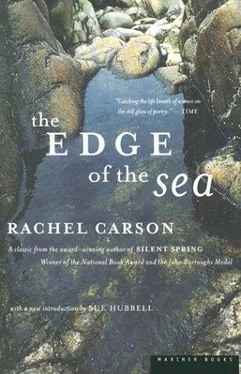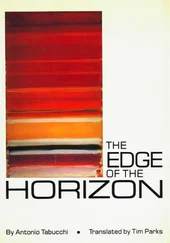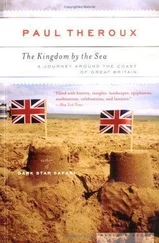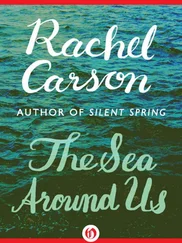Rachel Carson - The Edge of the Sea
Здесь есть возможность читать онлайн «Rachel Carson - The Edge of the Sea» весь текст электронной книги совершенно бесплатно (целиком полную версию без сокращений). В некоторых случаях можно слушать аудио, скачать через торрент в формате fb2 и присутствует краткое содержание. Город: Boston, Год выпуска: 1998, ISBN: 1998, Издательство: Mariner Books, Жанр: Биология, sci_ecology, sci_popular, на английском языке. Описание произведения, (предисловие) а так же отзывы посетителей доступны на портале библиотеки ЛибКат.
- Название:The Edge of the Sea
- Автор:
- Издательство:Mariner Books
- Жанр:
- Год:1998
- Город:Boston
- ISBN:978-0-395-07505-0
- Рейтинг книги:4 / 5. Голосов: 1
-
Избранное:Добавить в избранное
- Отзывы:
-
Ваша оценка:
- 80
- 1
- 2
- 3
- 4
- 5
The Edge of the Sea: краткое содержание, описание и аннотация
Предлагаем к чтению аннотацию, описание, краткое содержание или предисловие (зависит от того, что написал сам автор книги «The Edge of the Sea»). Если вы не нашли необходимую информацию о книге — напишите в комментариях, мы постараемся отыскать её.
A book to be read for pleasure as well as a practical identification guide,
introduces a world of teeming life where the sea meets the land. A new generation of readers is discovering why Rachel Carson’s books have become cornerstones of the environmental and conservation movements. New introduction by Sue Hubbell.
The Edge of the Sea — читать онлайн бесплатно полную книгу (весь текст) целиком
Ниже представлен текст книги, разбитый по страницам. Система сохранения места последней прочитанной страницы, позволяет с удобством читать онлайн бесплатно книгу «The Edge of the Sea», без необходимости каждый раз заново искать на чём Вы остановились. Поставьте закладку, и сможете в любой момент перейти на страницу, на которой закончили чтение.
Интервал:
Закладка:
There is a common thread that links these scenes and memories—the spectacle of life in all its varied manifestations as it has appeared, evolved, and sometimes died out. Underlying the beauty of the spectacle there is meaning and significance. It is the elusiveness of that meaning that haunts us, that sends us again and again into the natural world where the key to the riddle is hidden. It sends us back to the edge of the sea, where the drama of life played its first scene on earth and perhaps even its prelude; where the forces of evolution are at work today, as they have been since the appearance of what we know as life; and where the spectacle of living creatures faced by the cosmic realities of their world is crystal clear.
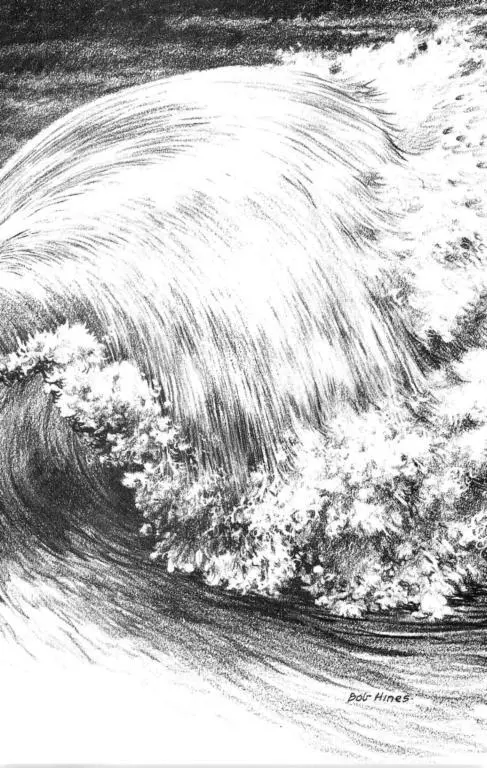
II. Patterns of Shore Life
THE EARLY HISTORY of life as it is written in the rocks is exceedingly dim and fragmentary, and so it is not possible to say when living things first colonized the shore, nor even to indicate the exact time when life arose. The rocks that were laid down as sediments during the first half of the earth’s history, in the Archeozoic era, have since been altered chemically and physically by the pressure of many thousands of feet of superimposed layers and by the intense heat of the deep regions to which they have been confined during much of their existence. Only in a few places, as in eastern Canada, are they exposed and accessible for study, but if these pages of the rock history ever contained any clear record of life, it has long since been obliterated.
The following pages—the rocks of the next several hundred million years, known as the Proterozoic era—are almost as disappointing. There are immense deposits of iron, which may possibly have been laid down with the help of certain algae and bacteria. Other deposits—strange globular masses of calcium carbonate—seem to have been formed by lime-secreting algae. Supposed fossils or faint impressions in these ancient rocks have been tentatively identified as sponges, jellyfish, or hard-shelled creatures with jointed legs called arthropods, but the more skeptical or conservative scientists regard these traces as having an inorganic origin.
Suddenly, following the early pages with their sketchy records, a whole section of the history seems to have been destroyed. Sedimentary rocks representing untold millions of years of pre-Cambrian history have disappeared, having been lost by erosion or possibly, through violent changes in the surface of the earth, brought into a location that now is at the bottom of the deep sea. Because of this loss a seemingly unbridgeable gap in the story of life exists.
The scarcity of fossil records in the early rocks and the loss of whole blocks of sediments may be linked with the chemical nature of the early sea and the atmosphere. Some specialists believe that the pre-Cambrian ocean was deficient in calcium or at least in the conditions that make easily possible the secretion of calcium shells and skeletons. If so, its inhabitants must have been for the most part soft-bodied and so not readily fossilized. A large amount of carbon dioxide in the atmosphere and its relative deficiency in the sea would also have affected the weathering of rock, according to geological theory, so that the sedimentary rocks of pre-Cambrian time must have been repeatedly eroded, washed away, and newly sedimented, with consequent destruction of fossils.
When the record is resumed in the rocks of the Cambrian period, which are about half a billion years old, all the major groups of invertebrate animals (including the principal inhabitants of the shore) suddenly appear, fully formed and flourishing. There are sponges and jellyfish, worms of all sorts, a few simple snail-like mollusks, and arthropods. Algae also are abundant, although no higher plants appear. But the basic plan of each of the large groups of animals and plants that now inhabit the shore had been at least projected in those Cambrian seas, and we may suppose, on good evidence, that the strip between the tide lines 500 million years ago bore at least a general resemblance to the intertidal area of the present stage of earth history.
We may suppose also that for at least the preceding halfbillion years those invertebrate groups, so well developed in the Cambrian, had been evolving from simpler forms, although what they looked like we may never know. Possibly the larval stages of some of the species now living may resemble those ancestors whose remains the earth seems to have destroyed or failed to preserve.
During the hundreds of millions of years since the dawn of the Cambrian, sea life has continued to evolve. Subdivisions of the original basic groups have arisen, new species have been created, and many of the early forms have disappeared as evolution has developed others better fitted to meet the demands of their world. A few of the primitive creatures of Cambrian time have representatives today that are little changed from their early ancestors, but these are the exception. The shore, with its difficult and changing conditions, has been a testing ground in which the precise and perfect adaptation to environment is an indispensable condition of survival.
All the life of the shore—the past and the present—by the very fact of its existence there, gives evidence that it has dealt successfully with the realities of its world—the towering physical realities of the sea itself, and the subtle life relationships that bind each living thing to its own community. The patterns of life as created and shaped by these realities intermingle and overlap so that the major design is exceedingly complex.
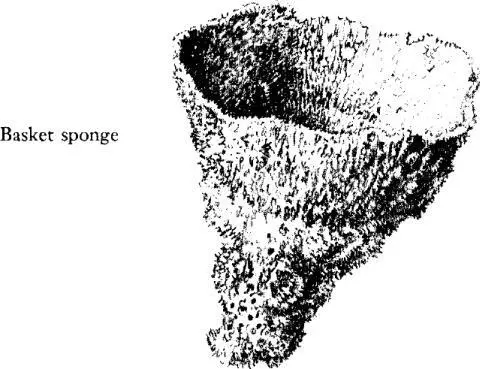

Whether the bottom of the shallow waters and the intertidal area consists of rocky cliffs and boulders, of broad plains of sand, or of coral reefs and shallows determines the visible pattern of life. A rocky coast, even though it is swept by surf, allows life to exist openly through adaptations for clinging to the firm surfaces provided by the rocks and by other structural provisions for dissipating the force of the waves. The visible evidence of living things is everywhere about—a colorful tapestry of seaweeds, barnacles, mussels, and snails covering the rocks—while more delicate forms find refuge in cracks and crevices or by creeping under boulders. Sand, on the other hand, forms a yielding, shifting substratum of unstable nature, its particles incessantly stirred by the waves, so that few living things can establish or hold a place on its surface or even in its upper layers. All have gone below, and in burrows, tubes, and underground chambers the hidden life of the sands is lived. A coast dominated by coral reefs is necessarily a warm coast, its existence made possible by warm ocean currents establishing the climate in which the coral animals can thrive. The reefs, living or dead, provide a hard surface to which living things may cling. Such a coast is somewhat like one bordered by rocky cliffs, but with differences introduced by smothering layers of chalky sediments. The richly varied tropical fauna of coral coasts has therefore developed special adaptations that set it apart from the life of mineral rock or sand. Because the American Atlantic coast includes examples of all three types of shore, the various patterns of life related to the nature of the coast itself are displayed there with beautiful clarity.
Still other patterns are superimposed on the basic geologic ones. The surf dwellers are different from those who live in quiet waters, even if members of the same species. In a region of strong tides, life exists in successive bands or zones, from the high-water mark to the line of the lowest ebb tides; these zones are obscured where there is little tidal action or on sand beaches where life is driven underground. The currents, modifying temperature and distributing the larval stages of sea creatures, create still another world.
Читать дальшеИнтервал:
Закладка:
Похожие книги на «The Edge of the Sea»
Представляем Вашему вниманию похожие книги на «The Edge of the Sea» списком для выбора. Мы отобрали схожую по названию и смыслу литературу в надежде предоставить читателям больше вариантов отыскать новые, интересные, ещё непрочитанные произведения.
Обсуждение, отзывы о книге «The Edge of the Sea» и просто собственные мнения читателей. Оставьте ваши комментарии, напишите, что Вы думаете о произведении, его смысле или главных героях. Укажите что конкретно понравилось, а что нет, и почему Вы так считаете.
